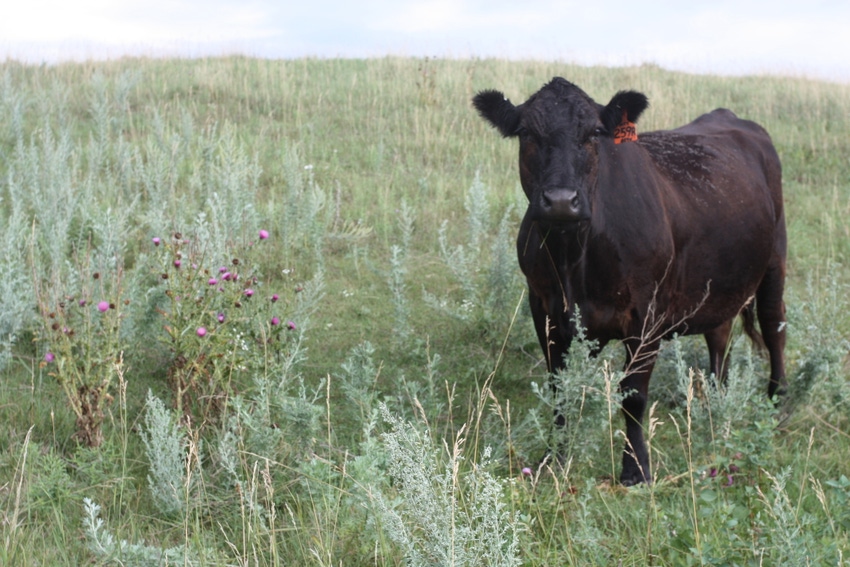Want to promote healthy pastures for next spring? Consider controlling weeds now before winter hits.
September 5, 2018

Weeds — they compete for nutrients in our pastures and choke out crops in the fields. They spread quickly, reduce the palatability of our forages, irritate our cows’ eyes, can be poisonous to our livestock and can be costly and labor intensive to control. And, while we typically think about controlling weeds in the spring and summer, fall is a great time to minimize and control winter annuals, biennials and cool season perennial weeds.
Here are four tips for making the biggest impact when choosing the best controls for weeds in your pastures:
1. Promote growth & use herbicides in alfalfa fields.
Mark Landefeld, Ohio State University Extension educator, says the best way to control weeds in established alfalfa fields is to maintain a dense, healthy forage stand through proper fertilization. If considering the use of herbicides, he says the quality of the stand should be evaluated and renovation and reseeding may be necessary and more cost effective than spraying.
Landefeld warns of the costs of letting weeds take over an alfalfa stand. He writes, “Some alfalfa stands have been reported to lose up to 30% of the stand from infestations of common chickweed.
“If chickweed emerges through the fall and into spring, it develops a thick, lush mat that competes strongly with the alfalfa until first cutting hay is made. Purple deadnettle and henbit can cause the same problem.
“If these weeds persist and then die, summer annual weeds like foxtails, lambsquarter, pigweed or others often take over. Perennial weeds such as dandelion or Canada thistle can also creep into portions of the growing area to reduce yields and/or quality even further. In many cases, herbicides can be used to eliminate weed pressure in alfalfa stands if you choose to do so, but always read the label.”
READ: Got invasive weeds in your pastures? Get some bugs.
2. Proper grazing is your best weapon in pastures.
Landefeld says that 95% of weed problems can be cured with good grazing and harvest management practices.
He writes, “When weeds invade mixed legume/grass stands, it poses a little different problem than pure stands because herbicide management strategies are limited that remove broadleaf weeds without killing your legumes. Grazing management and harvest management provide help here if you do not allow weeds to mature to the stage of viable seed production, but this is extremely hard to accomplish.
“So, spending money to provide good fertility may be the best and most cost effective means to reduce weed pressure in mixed grass/legume stands. Good soil fertility and maintaining soil pH of 6.5-7 helps forage plants vigorously compete against weeds.
“It is also critical, in fields used for hay and grazing, that livestock are not allowed to overgraze forage plants. This can cause the desirable plant’s root reserves to be used and weeds quickly take the opportunity to start growing.”
READ: “Get after the weeds yet this fall” by Mark Landefeld
3. Timing is everything.
Clif Little, OSU Extension educator, shares strategies for controlling annual, biennial and perennial weeds. With each, the timing will determine how successful you are in this approach.
Little says, “Annuals are best controlled during the seedling and early vegetative stages. As annuals mature, tissues harden and the plant becomes less responsive to herbicides.”
Meanwhile, he says biennials are best controlled during the seedling and rosette stage with broadleaf herbicides.
And perennials are best controlled, he says, during the early-bud stage (2 weeks before flowering).
He writes, “During the early-bud stage, sugar direction is moving toward root structures, and there is adequate leaf area to take in herbicide while the plants are at their lowest energy level. Remember the brush hog and grazing can be tools utilized to set back plant maturity and consequently may improve weed response to herbicides.”
4. Regularly mow or clip down weeds, but be prepared to use a herbicide, too.
Little explains, “Summer annuals such as horseweed, common ragweed, giant ragweed, lambs quarter, yellow foxtail and velvetleaf can be partially controlled through regular clipping or mowing. If herbicide applications are used, control is best when annuals are actively growing in the spring or fall. Problem biennials such as bull thistle, musk thistle, burdock and poison hemlock will respond to herbicide treatments similar to annuals.”
READ: “Pasture and forage weed control; mow or spray?” by Clif Little
I had a cowboy from western South Dakota tell me once that cattle will eat everything, including weeds, in a pasture if you train them to do so. He insisted that herbicide controls are unnecessary in most grazing situations. However, in areas where rainfall is plentiful and new growth is quick, weeds can quickly take over if ignored.
Pay attention to your pastures this fall and take the necessary steps now to promote healthy forages next spring.
The opinions of Amanda Radke are not necessarily those of beefmagazine.com or Farm Progress.
About the Author(s)
You May Also Like





